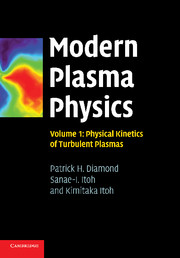Book contents
- Frontmatter
- Contents
- Preface
- Acknowledgements
- 1 Introduction
- 2 Conceptual foundations
- 3 Quasi-linear theory
- 4 Nonlinear wave–particle interaction
- 5 Kinetics of nonlinear wave–wave interaction
- 6 Closure theory
- 7 Disparate scale interactions
- 8 Cascades, structures and transport in phase space turbulence
- 9 MHD turbulence
- Appendix 1 Charney–Hasegawa–Mima equation
- Appendix 2 Nomenclature
- References
- Index
9 - MHD turbulence
Published online by Cambridge University Press: 05 October 2010
- Frontmatter
- Contents
- Preface
- Acknowledgements
- 1 Introduction
- 2 Conceptual foundations
- 3 Quasi-linear theory
- 4 Nonlinear wave–particle interaction
- 5 Kinetics of nonlinear wave–wave interaction
- 6 Closure theory
- 7 Disparate scale interactions
- 8 Cascades, structures and transport in phase space turbulence
- 9 MHD turbulence
- Appendix 1 Charney–Hasegawa–Mima equation
- Appendix 2 Nomenclature
- References
- Index
Summary
Yet not every solution of the equation of motion, even if it is exact, can actually occur in Nature.
(L. D. Landau and E. M. Lifshitz, Fluid Mechanics)Introduction to MHD turbulence
In this chapter, we explain some of the basic ideas in MHD turbulence and turbulent transport, with special attention to incompressible and weakly compressible dynamics with a mean magnetic field. We emphasize intuition, ideas and basic notions rather than detailed results. Throughout Chapters 2 to 8, the examples were drawn primarily from cases involving electrostatic perturbations. In homogeneous plasmas, the fundamental excitations include electron plasma waves, ion sound waves and Alfvén waves. The electron plasma wave is the best venue to understand microscopic excitations by particle discreteness and particle resonance with collective motions. The ion sound wave is the other fundamental electrostatic mode, and is the simplest that mediates inter-species momentum exchange. In particular, adding inhomogeneity to magnetized plasmas, this wave connects to the drift wave, and the nonlinear evolution of drift waves is the focus of turbulence theory for confined plasmas. In addition, the combination of the plasma wave and ion sound wave defines the problem of disparate-scale interaction, which is a prototype mechanism for structure formation in plasmas. However, Alfvén waves are central to the dynamics of magnetized plasmas in nearly all circumstances.
- Type
- Chapter
- Information
- Modern Plasma Physics , pp. 348 - 384Publisher: Cambridge University PressPrint publication year: 2010



